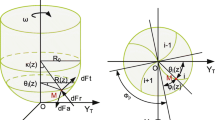Abstract
This paper presents a new method for calibrating the cutting force coefficients and the cutter runout parameters simultaneously in peripheral milling. In order to reflect the size effect, the lumped-mechanism model is employed, in which the instantaneous cutting force coefficients are treated by an exponent function of the instantaneous uncut chip thickness. To calibrate the empirical force coefficients, the mathematical relationships between the instantaneous cutting forces and the instantaneous uncut chip thickness are established with the initial runout parameters firstly. Then, the cutting force coefficients can be obtained by solving the contradiction equations with least-squares fitting method. Thereafter, the normalized mean square error is achieved by comparing the simulation results and the experiment results. The particle swarm optimization method is adopted to predict the cutting force coefficients and the runout parameters by minimizing the normalized mean square error. Finally, the milling tests over a wide range of cutting conditions are conducted to verify the proposed method, and the results show that the predicted cutting forces agree well with the experiment results. Besides, the method proposed in this paper has higher prediction accuracy than the average force method.
Similar content being viewed by others
References
Altintas Y, Spence A (1991) End milling force algorithms for CAD systems. CIRP Ann-Manuf Techn 40(1):31–34
Wan M, Zhang WH, Dang JW, Yang Y (2010) A novel cutting force modeling method for cylindrical end mill. Appl Math Model 34(3):823–836
Azeem A, Feng HY, Wang LH (2004) Simplified and efficient calibration of a mechanistic cutting force model for ball-end-milling. Int J Mach Tool Manuf 44(2-3):291–298
Bhattacharyya A, Schueller JK, Mann BP, Ziegert JC, Schmitz TL, Taylor FJ, Fitz-Coy NG (2010) A closed form mechanistic cutting force model for helical peripheral milling of ductile metallic alloys. Int J Mach Tool Manuf 50(6):538–551
Wang BS, Hao HY, Wang WL, Hou JM, Feng Y (2013) Identification of instantaneous cutting force coefficients using surface error. Int J Adv Manuf Tech 68(1-4):701–709
Kline WA, DeVor RE, Lindberg JR (1982) The prediction of cutting forces in end milling with application to cornering cuts. Int J Mach Tool Manuf 22(1):7–22
Koenigsberger F, Sabberwal AJP (1961) An investigation into the cutting force pulsations during milling operations. Int J Mach Tool Manuf 1(1-2):15–33
Wang B, Hao HY, Wang ML, Hou JM, Feng Y (2013) Identification of instantaneous cutting force coefficients using surface error. Int J Adv Manuf Technol 68:701–709
Perez H, Diez E, Marquez JJ, Vizan A (2013) An enhanced method for cutting force estimation in peripheral milling. Int J Adv Manuf Technol 69:1731–1741
Gonzalo O, Beristain J, Jauregi H, Sanz C (2010) A method for the identification of the specific force coefficients for mechanistic milling simulation. Int J Mach Tool Manuf 50(9):765–774
Adem KAM, Fales R, El-Gizawy AS (2015) Identification of cutting force coefficients for the linear and nonlinear force models in end milling process using average forces and optimization technique methods. Int J Adv Manuf Tech 79(9):1671–1678
Wan HY, Qin XD, Ren CZ, Wang Q (2012) Prediction of cutting forces in helical milling process. Int J Adv Manuf Tech 58(9-12):849–859
Kao YC, Nguyen NT, Chen MS, Su ST (2015) A prediction method of cutting force coefficients with helix angle of flat-end cutter and its application in a virtual three-axis milling simulation system. Int J Adv Manuf Tech 77(9-12):1793–1809
Schmitz TL, Smith KS (2008) Machining dynamics: frequency response to improved productivity. Springer Science, New York
Gradisek J, Kalveram M, Weinert K (2004) Mechanistic identification of specific force coefficients for a general end mill. Int J Mach Tool Manuf 44(4):401–414
Wang HY, Qin XD, Ren CZ, Wang Q (2012) Prediction of cutting forces in helical milling process. Int J Adv Manuf Technol 58(9):849–859
Zhang DL, Mo R, Chang ZY, Sun HB, Li CL (2016) A study of computing accuracy of calibrating cutting force coefficients and run-out parameters in flat-end milling. Int J Adv Manuf Technol 84(1):621–630
Wan M, Lu MS, Zhang WH, Yang Y (2012) A new ternary-mechanism model for the prediction of cutting forces in flat end milling. Int J Mach Tool Manuf 57:502–509
Wan M, Zhang WH (2009) Systematic study on cutting force modelling methods for peripheral milling. Int J Mach Tool Manuf 49(5):424–432
Wan M, Zhang WH, Tan G, Qin GH (2007) New cutting force modeling approach for flat end mill. Chin J Aeronaut 20(3):282–288
Yucesan G, Altintas Y (1994) Improved modeling of cutting force coefficients in peripheral milling. Int J Mach Tool Manuf 34(4):473–487
Sonawane HA, Joshi SS (2010) Analytical modeling of chip geometry and cutting forces in helical ball end milling of superalloy Inconel 718. J Manuf Sci E-T ASME 3(3):204–217
Budak E, Altintas Y, Armarego EJA (1996) Prediction of milling force coefficients from orthogonal cutting data. J Manuf Sci E-T ASME 118:216–224
Armarego EJA, Despande NP (1989) Computerized predictive cutting model for cutting forces in end-milling including eccentricity effects. CIRP Ann-Manuf Techn 38(1):45–49
Lin B, Wang L, Guo Y, Yao JM (2016) Modeling of cutting forces in end milling based on oblique cutting analysis. Int J Adv Manuf Technol 84(1):727–736
Altintas Y (2000) Manufacturing automation. Cambridge University Press, Cambridge
Author information
Authors and Affiliations
Corresponding author
Rights and permissions
About this article
Cite this article
Zhang, Z., Li, H., Meng, G. et al. A new procedure for the prediction of the cutting forces in peripheral milling. Int J Adv Manuf Technol 89, 1709–1715 (2017). https://doi.org/10.1007/s00170-016-9186-z
Received:
Accepted:
Published:
Issue Date:
DOI: https://doi.org/10.1007/s00170-016-9186-z



